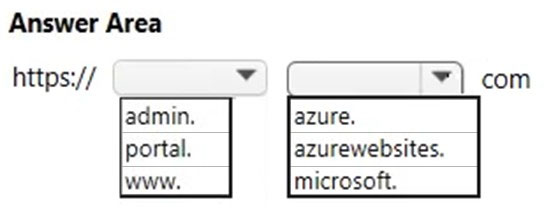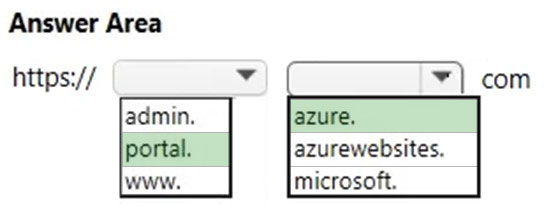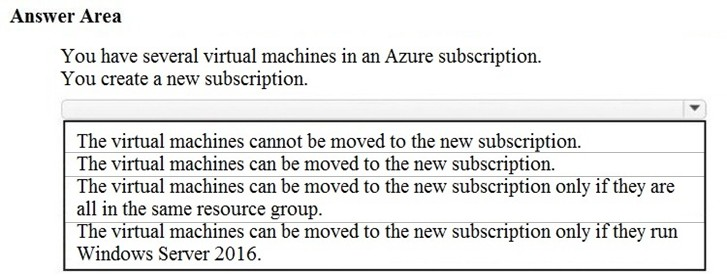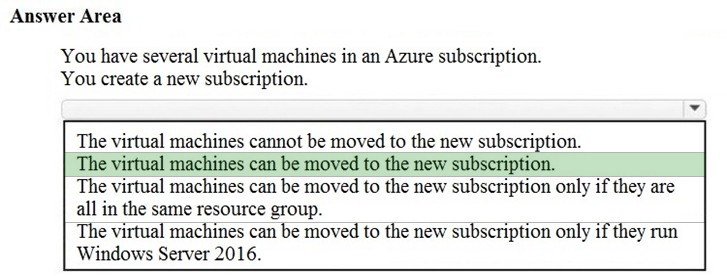AZ-900: Microsoft Azure Fundamentals
This question requires that you evaluate the underlined text to determine if it is correct.
An Azure region contains one or more data centers that are connected by using a low-latency network.
Instructions: Review the underlined text. If it makes the statement correct, select No change is needed. If the statement is incorrect, select the answer choice that makes the statement correct.
No change is needed
Is found in each country where Microsoft has a subsidiary office
Can be found in every country in Europe and the Americas only
Contains one or more data centers that are connected by using a high-latency network
Answer is No change is needed
A region is a set of data centres deployed within a latency-defined perimeter and connected through a dedicated regional low-latency network. Microsoft Azure currently has 55 regions worldwide.
Regions are divided into Availability Zones. Availability Zones are physically separate locations within an Azure region. Each Availability Zone is made up of one or more datacenters equipped with independent power, cooling, and networking.
References:
https://azure.microsoft.com/en-gb/global-infrastructure/regions/
This question requires that you evaluate the underlined text to determine if it is correct.
One of the benefits of Azure SQL Data Warehouse is that high availability is built into the platform.
Instructions: Review the underlined text. If it makes the statement correct, select No change is needed. If the statement is incorrect, select the answer choice that makes the statement correct.
No change is needed
automatic scaling
data compression
versioning
Answer is No change is needed
Azure Data Warehouse (now known as Azure Synapse Analytics) is a PaaS offering from Microsoft. As with all PaaS services from Microsoft, SQL Data Warehouse offers an availability SLA of 99.9%. Microsoft can offer 99.9% availability because it has high availability features built into the platform.
References:
https://docs.microsoft.com/en-us/azure/sql-data-warehouse/sql-data-warehouse-overview-faq
You plan to store 20 TB of data in Azure. The data will be accessed infrequently and visualized by using Microsoft Power BI.
You need to recommend a storage solution for the data.
Which two solutions should you recommend?
Azure Data Lake
Azure Cosmos DB
Azure SQL Data Warehouse
Azure SQL Database
Azure Database for PostgreSQL
Answers are;
Azure Data Lake
Azure SQL Data Warehouse
You can use Power BI to analyze and visualize data stored in Azure Data Lake and Azure SQL Data Warehouse.
Azure Data Lake includes all of the capabilities required to make it easy for developers, data scientists and analysts to store data of any size and shape and at any speed, and do all types of processing and analytics across platforms and languages. It removes the complexities of ingesting and storing all your data while making it faster to get up and running with batch, streaming and interactive analytics. It also integrates seamlessly with operational stores and data warehouses so that you can extend current data applications.
References:
https://docs.microsoft.com/en-us/azure/data-lake-store/data-lake-store-power-bi
https://azure.microsoft.com/en-gb/solutions/data-lake
You have an Azure environment that contains 10 web apps. To which URL should you connect to manage all the Azure resources?


The Azure portal is a web-based management interface where you can view and manage all your Azure resources in one unified hub, including web apps, databases, virtual machines, virtual networks, storage and Visual Studio team projects.
References:
https://azure.microsoft.com/en-gb/features/azure-portal/
To complete the sentence, select the appropriate option in the answer area.


You can move a VM and its associated resources to a different subscription by using the Azure portal.
Moving between subscriptions can be handy if you originally created a VM in a personal subscription and now want to move it to your company's subscription to continue your work. You do not need to start the VM in order to move it and it should continue to run during the move.
Reference:
https://docs.microsoft.com/en-us/azure/virtual-machines/windows/move-vm
You plan to map a network drive from several computers that run Windows 10 to Azure Storage.
You need to create a storage solution in Azure for the planned mapped drive.
What should you create?
an Azure SQL database
a virtual machine data disk
a Files service in a storage account
a Blobs service in a storage account
Answer is a Files service in a storage account
Azure Files is Microsoft's easy-to-use cloud file system. Azure file shares can be seamlessly used in Windows and Windows Server.
To use an Azure file share with Windows, you must either mount it, which means assigning it a drive letter or mount point path, or access it via its UNC path.
Unlike other SMB shares you may have interacted with, such as those hosted on a Windows Server, Linux Samba server, or NAS device, Azure file shares do not currently support Kerberos authentication with your Active Directory (AD) or Azure Active Directory (AAD) identity, although this is a feature we are working on.
Instead, you must access your Azure file share with the storage account key for the storage account containing your Azure file share. A storage account key is an administrator key for a storage account, including administrator permissions to all files and folders within the file share you're accessing, and for all file shares and other storage resources (blobs, queues, tables, etc) contained within your storage account.
References:
https://docs.microsoft.com/en-us/azure/storage/files/storage-how-to-use-files-windows
Which Azure service should you use to collect events from multiple resources into a centralized repository?
Azure Event Hubs
Azure Analysis Services
Azure Monitor
Azure Stream Analytics
Answer is Azure Event Hubs
Azure Event Hubs is a big data streaming platform and event ingestion service. It can receive and process millions of events per second. Data sent to an event hub can be transformed and stored by using any real-time analytics provider or batching/storage adapters.
Azure Event Hubs can be used to ingest, buffer, store, and process your stream in real time to get actionable insights. Event Hubs uses a partitioned consumer model, enabling multiple applications to process the stream concurrently and letting you control the speed of processing.
Azure Event Hubs can be used to capture your data in near-real time in an Azure Blob storage or Azure Data Lake Storage for long-term retention or micro-batch processing.
Reference:
https://docs.microsoft.com/en-us/azure/event-hubs/event-hubs-about
Which service provides serverless computing in Azure?
Azure Virtual Machines
Azure Functions
Azure storage account
Azure dedicated hosts
Answer is Azure Functions
Azure Functions provide a platform for serverless code.
Azure Functions is a serverless compute service that lets you run event-triggered code without having to explicitly provision or manage infrastructure.
Reference:
https://docs.microsoft.com/en-us/azure/azure-functions/
This question requires that you evaluate the underlined text to determine if it is correct.
Azure Databricks is an Apache Spark-based analytics service.
Instructions: Review the underlined text. If it makes the statement correct, select No change is needed. If the statement is incorrect, select the answer choice that makes the statement correct.
No change is needed.
Azure Data Factory
Azure DevOps
Azure HDInsight
Answer is No change is needed.
Azure Databricks is an Apache Spark-based analytics platform. The platform consists of several components including MLib. Mlib is a Machine Learning library consisting of common learning algorithms and utilities, including classification, regression, clustering, collaborative filtering, dimensionality reduction, as well as underlying optimization primitives.
References:
https://docs.microsoft.com/en-us/azure/azure-databricks/what-is-azure-databricks#apache-spark-based-analytics-platform
Your company has datacenters in Los Angeles and New York. The company has a Microsoft Azure subscription.
You are configuring the two datacenters as geo-clustered sites for site resiliency.
You need to recommend an Azure storage redundancy option.
You have the following data storage requirements:
- Data must be stored on multiple nodes.
- Data must be stored on nodes in separate geographic locations.
- Data can be read from the secondary location as well as from the primary location
Which of the following Azure stored redundancy options should you recomm
Geo-redundant storage
Read-only geo-redundant storage
Zone-redundant storage
Locally redundant storage
Answer is Read-only geo-redundant storage
RA-GRS allows you to have higher read availability for your storage account by providing ג€read onlyג€ access to the data replicated to the secondary location. Once you enable this feature, the secondary location may be used to achieve higher availability in the event the data is not available in the primary region. This is an "opt-in" feature which requires the storage account be geo-replicated.
Geo-redundant storage (with GRS or GZRS) replicates your data to another physical location in the secondary region to protect against regional outages. However, that data is available to be read only if the customer or Microsoft initiates a failover from the primary to secondary region. When you enable read access to the secondary region, your data is available to be read at all times, including in a situation where the primary region becomes unavailable. For read access to the secondary region, enable read-access geo-redundant storage (RA-GRS) or read-access geo-zone-redundant storage (RA-GZRS).
References:
https://docs.microsoft.com/en-us/azure/storage/common/storage-redundancy